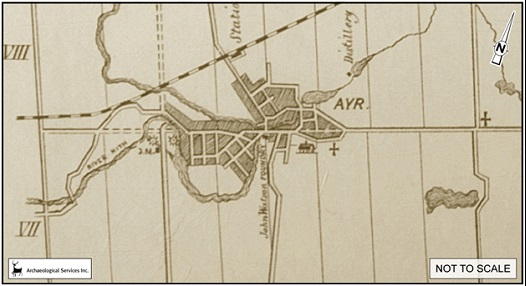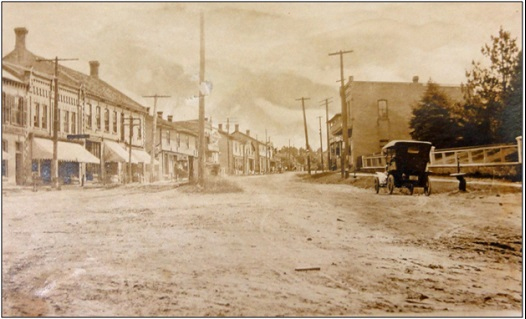
ASI recently conducted a cultural heritage resource assessment in the Village of Ayr in the Township of North Dumfries, Region of Waterloo. The purpose of the assessment was to create an inventory of built heritage resources and cultural heritage landscapes along three streets in the study area, including sections of Swan Street, Stanley Street, and Northumberland Street. The Village of Ayr is an exceptionally intact nineteenth-century village with numerous historic buildings and cultural heritage landscape features.
The village dates to 1824, when Abel Mudge constructed a sawmill and grist mill at the junction of Smith’s Creek (now the Nith River) and Cedar Creek. The site became known as Mudge’s Mills. A few years later, Abel Mudge petitioned the County and had a road built between his establishment and Roseville to the north in an effort to open up the area to settlers and development. This road was built in 1826 and was called Northumberland Street (Watson 1924; Rayburn 1997).

Settlement in the area around Mudge’s Mills began to increase significantly in the 1830s and 1840s, with a largely Scottish population settling in the area. To the east of Mudge’s Mills was Jedburgh which featured a flour mill and distillery established by the Scottish immigrant John Hall. The location of this site is commemorated by Jedburgh Pond and Hall Street, located in the northeast part of Ayr. The third hamlet was known as Nithvale, located west of Mudge’s Mills. A flour mill and two sawmills were established in the 1830s at Nithvale. These three settlements would eventually join to create the present limits of the Village of Ayr (Watson 1924.; Rayburn 1997). Remnants of the mills remain today and form cultural heritage landscapes within the village.

A foundry was established by John Watson in 1840 near the junction of Stanley Street and the Nith River that originally produced cast iron pots and stoves, and was later expanded to produce agricultural implements including high quality mowers, reapers, and threshing machines. It is a notable business given that its products were known throughout the Dominion of Canada and it was one of the largest employers in the township (Watson 1924.). The foundry remains extant today and is currently in use as a mall.
By 1860, the population of Ayr (including surrounding area) had increased to 1,000. By this time the Village of Ayr boasted a number of noteworthy buildings, including a library in 1849-50; a fire hall in 1863; a school house by 1842; and a church in 1834. In addition to these notable buildings, the Village of Ayr contains numerous examples of nineteenth and early twentieth century buildings that are still extant today. These buildings feature a variety of architectural styles and exhibit a high degree of craftsmanship.
The Village of Ayr retains the majority of its nineteenth-century buildings and landscapes and it is a delight to stroll through the downtown core of the village. ASI Cultural Heritage Specialists Lindsay Popert and Heidy Schopf highly recommend taking an afternoon to enjoy sights and historic streetscapes that the Village of Ayr has to offer.


